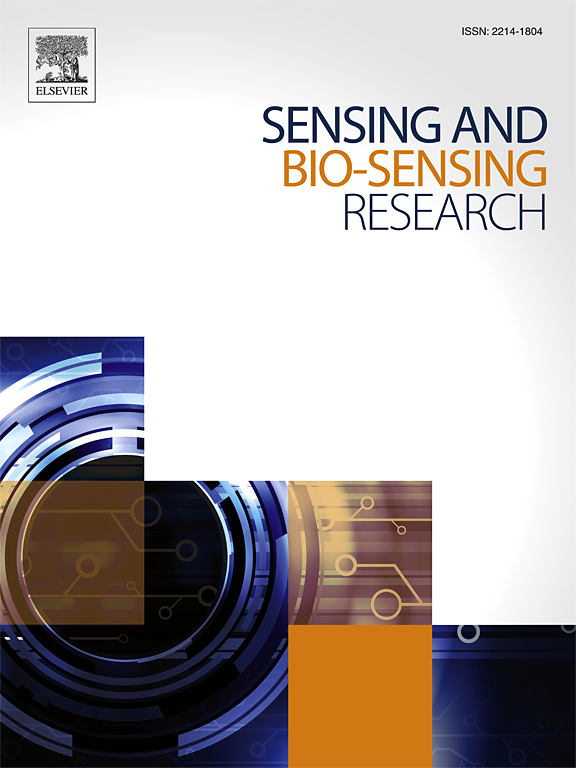基于磷光寿命光谱的片上溶解氧传感器,用于研究癌症光动力疗法中的活化参数
IF 4.9
Q1 CHEMISTRY, ANALYTICAL
引用次数: 0
摘要
开发了一种3d打印的光流芯片,其内置溶解氧传感器,具有时间分辨磷光寿命光谱平台,用于光动力治疗(PDT)中活性氧(ROS)动力学的间接分析。该平台通过实时测量PDT处理过程中的光致发光(PL)寿命(τ),实现了对ROS产生/消除的连续评估,揭示了光敏剂(PS)、激发激光和介质在该过程中对ROS产生的关键贡献。利用Rose Bengal (RB)作为PS,演示了该系统分析和调整PS激活参数(如PS浓度、激光曝光时间和功率)的能力。此外,该平台还提供了有关介质激活持续时间、PL寿命(∆τmax)的最大变化以及达到∆τmax的时间的重要信息。以含有胎牛血清(FBS)、RB和A375人黑色素瘤细胞系的Dulbecco改良鹰中高糖(DMEM HG)为代表,这些参数分别为1070 μs、4.4 μs和780 μs。两种ROS清除剂丙酮酸钠(SP)和对苯二甲酸(TA)的研究表明,超过90%的τ变化对应于OH•和H2O2自由基,证实了ROS的产生/消除与τ变化之间的相关性。并以1,3-二苯基异苯并呋喃(DPBF)为指示剂,与传统的吸收法和光致发光法进行了比较。与DPBF和类似指标不同,该片上系统除了提供ps激活和失活动态的实时数据外,还可以区分各种参数的贡献,并且在测量过程中不会消耗,可以多次重复使用。因此,开发的平台对芯片上药物分析和PDT治疗的开发以及其他生物医学应用具有潜在的好处。本文章由计算机程序翻译,如有差异,请以英文原文为准。

On-Chip DO sensor based on phosphorescence lifetime spectroscopy for investigation of activation parameters in photodynamic therapy of cancers
A 3D-printed optofluidic chip with an embedded dissolved oxygen sensor, empowered with a time-resolved phosphorescence lifetime spectroscopy platform, is developed for indirect analysis of reactive oxygen species (ROS) dynamics in photodynamic therapy (PDT). This platform is implemented for continuous evaluation of ROS production/elimination through real-time measurement of photoluminescence (PL) lifetime () during PDT treatment, revealing the key contributions of the photosensitizer (PS), excitation laser, and the medium in ROS generation during this process. Rose Bengal (RB) is utilized as a PS to demonstrate this system's capability to analyze and tune the PS activation parameters such as PS concentration, laser exposure time, and power. In addition, the platform provides important information on the medium activation duration, the maximum changes in the PL lifetime (max), and the time to reach max. For the Dulbecco's modified eagle medium high glucose (DMEM HG) containing fetal bovine serum (FBS), RB, and A375 human melanoma cell line as a representative example, these parameters are 1070 s, 4.4 μs, and 780 s respectively. Two ROS scavengers of sodium pyruvate (SP) and terephthalic acid (TA) are used to demonstrate that more than 90 % of the change in the corresponds to OH• and H2O2 radicals, confirming the correlation between ROS generation/elimination and variations. Moreover, this system is compared with conventional absorption and photoluminescent methods based on 1,3-diphenylisobenzofuran (DPBF) indicator. Unlike DPBF and similar indicators, this on-chip system besides providing real-time data on the dynamics of activation and deactivation of the PSs, enables distinguishing the contribution of various parameters, and is not consumed during the measurement and can be reused multiple times. Therefore, the developed platform is potentially beneficial for on-chip drug analysis and development in PDT therapy, as well as other biomedical applications.
求助全文
通过发布文献求助,成功后即可免费获取论文全文。
去求助
来源期刊

Sensing and Bio-Sensing Research
Engineering-Electrical and Electronic Engineering
CiteScore
10.70
自引率
3.80%
发文量
68
审稿时长
87 days
期刊介绍:
Sensing and Bio-Sensing Research is an open access journal dedicated to the research, design, development, and application of bio-sensing and sensing technologies. The editors will accept research papers, reviews, field trials, and validation studies that are of significant relevance. These submissions should describe new concepts, enhance understanding of the field, or offer insights into the practical application, manufacturing, and commercialization of bio-sensing and sensing technologies.
The journal covers a wide range of topics, including sensing principles and mechanisms, new materials development for transducers and recognition components, fabrication technology, and various types of sensors such as optical, electrochemical, mass-sensitive, gas, biosensors, and more. It also includes environmental, process control, and biomedical applications, signal processing, chemometrics, optoelectronic, mechanical, thermal, and magnetic sensors, as well as interface electronics. Additionally, it covers sensor systems and applications, µTAS (Micro Total Analysis Systems), development of solid-state devices for transducing physical signals, and analytical devices incorporating biological materials.
 求助内容:
求助内容: 应助结果提醒方式:
应助结果提醒方式:


